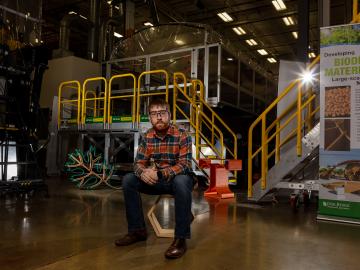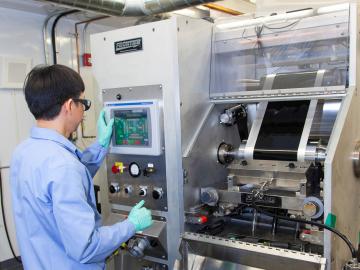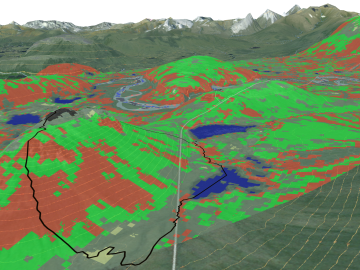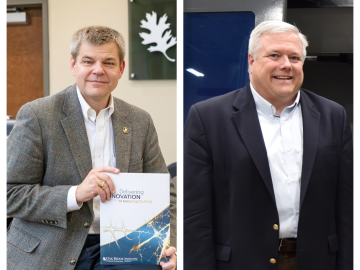
Filter News
Area of Research
- (-) Energy Science (167)
- Advanced Manufacturing (22)
- Biological Systems (2)
- Biology and Environment (134)
- Biology and Soft Matter (1)
- Building Technologies (2)
- Computational Biology (1)
- Computational Engineering (3)
- Computer Science (15)
- Electricity and Smart Grid (1)
- Functional Materials for Energy (1)
- Fusion and Fission (9)
- Fusion Energy (3)
- Isotopes (2)
- Materials (73)
- Materials for Computing (13)
- Mathematics (1)
- National Security (33)
- Neutron Science (31)
- Nuclear Science and Technology (12)
- Quantum information Science (7)
- Supercomputing (115)
News Topics
- (-) 3-D Printing/Advanced Manufacturing (79)
- (-) Bioenergy (26)
- (-) Chemical Sciences (14)
- (-) Computer Science (25)
- (-) Environment (54)
- (-) Machine Learning (7)
- (-) Mercury (3)
- (-) Molten Salt (1)
- Advanced Reactors (6)
- Artificial Intelligence (8)
- Big Data (5)
- Biology (11)
- Biomedical (6)
- Biotechnology (4)
- Buildings (38)
- Clean Water (8)
- Composites (17)
- Coronavirus (12)
- Critical Materials (9)
- Cybersecurity (8)
- Energy Storage (71)
- Exascale Computing (2)
- Fossil Energy (2)
- Frontier (2)
- Fusion (1)
- Grid (39)
- High-Performance Computing (6)
- Hydropower (3)
- Isotopes (1)
- Materials (35)
- Materials Science (26)
- Mathematics (2)
- Microelectronics (1)
- Microscopy (8)
- Nanotechnology (8)
- National Security (5)
- Neutron Science (11)
- Nuclear Energy (7)
- Partnerships (12)
- Physics (1)
- Polymers (11)
- Quantum Science (2)
- Security (6)
- Simulation (4)
- Space Exploration (3)
- Statistics (1)
- Summit (4)
- Transportation (66)
Media Contacts

Alex Roschli is no stranger to finding himself in unique situations. After all, the early career researcher in ORNL’s Manufacturing Systems Research group bears a last name that only 29 other people share in the United States, and he’s certain he’s the only Roschli (a moniker that hails from Switzerland) with the first name Alex.

A residential and commercial tower under development in Brooklyn that is changing the New York City skyline has its roots in research at the Department of Energy’s Oak Ridge National Laboratory.
Higher carbon dioxide levels caused 30 percent more wood growth in young forest stands across the temperate United States over a decade, according to an analysis led by Oak Ridge National Laboratory.

The use of lithium-ion batteries has surged in recent years, starting with electronics and expanding into many applications, including the growing electric and hybrid vehicle industry. But the technologies to optimize recycling of these batteries have not kept pace.

Oak Ridge National Laboratory scientists have created open source software that scales up analysis of motor designs to run on the fastest computers available, including those accessible to outside users at the Oak Ridge Leadership Computing Facility.

A team of scientists led by Oak Ridge National Laboratory used machine learning methods to generate a high-resolution map of vegetation growing in the remote reaches of the Alaskan tundra.
![Coexpression_hi-res_image[1].jpg Coexpression_hi-res_image[1].jpg](/sites/default/files/styles/list_page_thumbnail/public/Coexpression_hi-res_image%5B1%5D_0.jpg?itok=ww635BCP)
While studying the genes in poplar trees that control callus formation, scientists at Oak Ridge National Laboratory have uncovered genetic networks at the root of tumor formation in several human cancers.

Two leaders in US manufacturing innovation, Thomas Kurfess and Scott Smith, are joining the Department of Energy’s Oak Ridge National Laboratory to support its pioneering research in advanced manufacturing.
Scientists studying a valuable, but vulnerable, species of poplar have identified the genetic mechanism responsible for the species’ inability to resist a pervasive and deadly disease. Their finding, published in the Proceedings of the National Academy of Sciences, could lead to more successful hybrid poplar varieties for increased biofuels and forestry production and protect native trees against infection.



